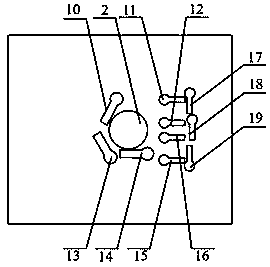Preparation method for microfluidic photoelectrochemical sensor for heart failure marker B-type natriuretic peptide
A photoelectrochemical and microfluidic technology, used in chemical instruments and methods, laboratory containers, scientific instruments, etc., can solve the problems of cumbersome detection methods, high detection limits, and high costs, achieving high repeatability, The effect of low detection limit and high detection sensitivity
- Summary
- Abstract
- Description
- Claims
- Application Information
AI Technical Summary
Problems solved by technology
Method used
Image
Examples
Embodiment 1
[0036] A method for preparing a microfluidic photoelectrochemical sensor for detecting heart failure marker B-type natriuretic peptide, the preparation steps are as follows:
[0037] (1) Use the computer design software AUTOCAD to design and draw the channel graphics of the microfluidic chip;
[0038] (2) Use the designed graphics to draw the mask plate, and use standard soft lithography technology to process the microfluidic polydimethylsiloxane PDMS chip, including the microfluidic upper chip, the lower chip, and the gap between the upper chip and the lower chip diaphragm;
[0039] (3) The 8 cm × 3 cm ITO conductive glass was ultrasonically cleaned with acetone, ethanol and ultrapure water for 30 min, respectively, and dried with nitrogen;
[0040] (4) Drop-coat 20 µL, 6.0 mg / mL zinc oxide ZnO solution on the conductive surface of ITO conductive glass, let it dry at room temperature, continue to drop-coat 20 µL, 3.0 mg / mL bismuth oxyiodide / bismuth sulfide BiOI / Bi 2 S 3 ...
Embodiment 2
[0046] A method for preparing a microfluidic photoelectrochemical sensor for detecting heart failure marker B-type natriuretic peptide, the preparation steps are as follows:
[0047] (1) Use the computer design software AUTOCAD to design and draw the channel graphics of the microfluidic chip;
[0048] (2) Use the designed graphics to draw the mask plate, and use standard soft lithography technology to process the microfluidic polydimethylsiloxane PDMS chip, including the microfluidic upper chip, the lower chip, and the gap between the upper chip and the lower chip diaphragm;
[0049] (3) The 8 cm × 3 cm ITO conductive glass was ultrasonically cleaned with acetone, ethanol and ultrapure water for 30 min, respectively, and dried with nitrogen;
[0050] (4) Drop-coat 20 µL, 7.0 mg / mL zinc oxide ZnO solution on the conductive surface of ITO conductive glass, let it dry at room temperature, continue to drop-coat 20 µL, 4.0 mg / mL bismuth oxyiodide / bismuth sulfide BiOI / Bi 2 S 3 ...
Embodiment 3
[0056] A method for preparing a microfluidic photoelectrochemical sensor for detecting heart failure marker B-type natriuretic peptide, the preparation steps are as follows:
[0057] (1) Use the computer design software AUTOCAD to design and draw the channel graphics of the microfluidic chip;
[0058] (2) Use the designed graphics to draw the mask plate, and use standard soft lithography technology to process the microfluidic polydimethylsiloxane PDMS chip, including the microfluidic upper chip, the lower chip, and the gap between the upper chip and the lower chip diaphragm;
[0059] (3) The 8 cm × 3 cm ITO conductive glass was ultrasonically cleaned with acetone, ethanol and ultrapure water for 30 min, respectively, and dried with nitrogen;
[0060] (4) Drop-coat 20 µL, 8.0 mg / mL zinc oxide ZnO solution on the conductive surface of ITO conductive glass, let it dry at room temperature, continue to drop-coat 20 µL, 5.0 mg / mL bismuth oxyiodide / bismuth sulfide BiOI / Bi 2 S 3 ...
PUM
 Login to View More
Login to View More Abstract
Description
Claims
Application Information
 Login to View More
Login to View More - R&D
- Intellectual Property
- Life Sciences
- Materials
- Tech Scout
- Unparalleled Data Quality
- Higher Quality Content
- 60% Fewer Hallucinations
Browse by: Latest US Patents, China's latest patents, Technical Efficacy Thesaurus, Application Domain, Technology Topic, Popular Technical Reports.
© 2025 PatSnap. All rights reserved.Legal|Privacy policy|Modern Slavery Act Transparency Statement|Sitemap|About US| Contact US: help@patsnap.com



